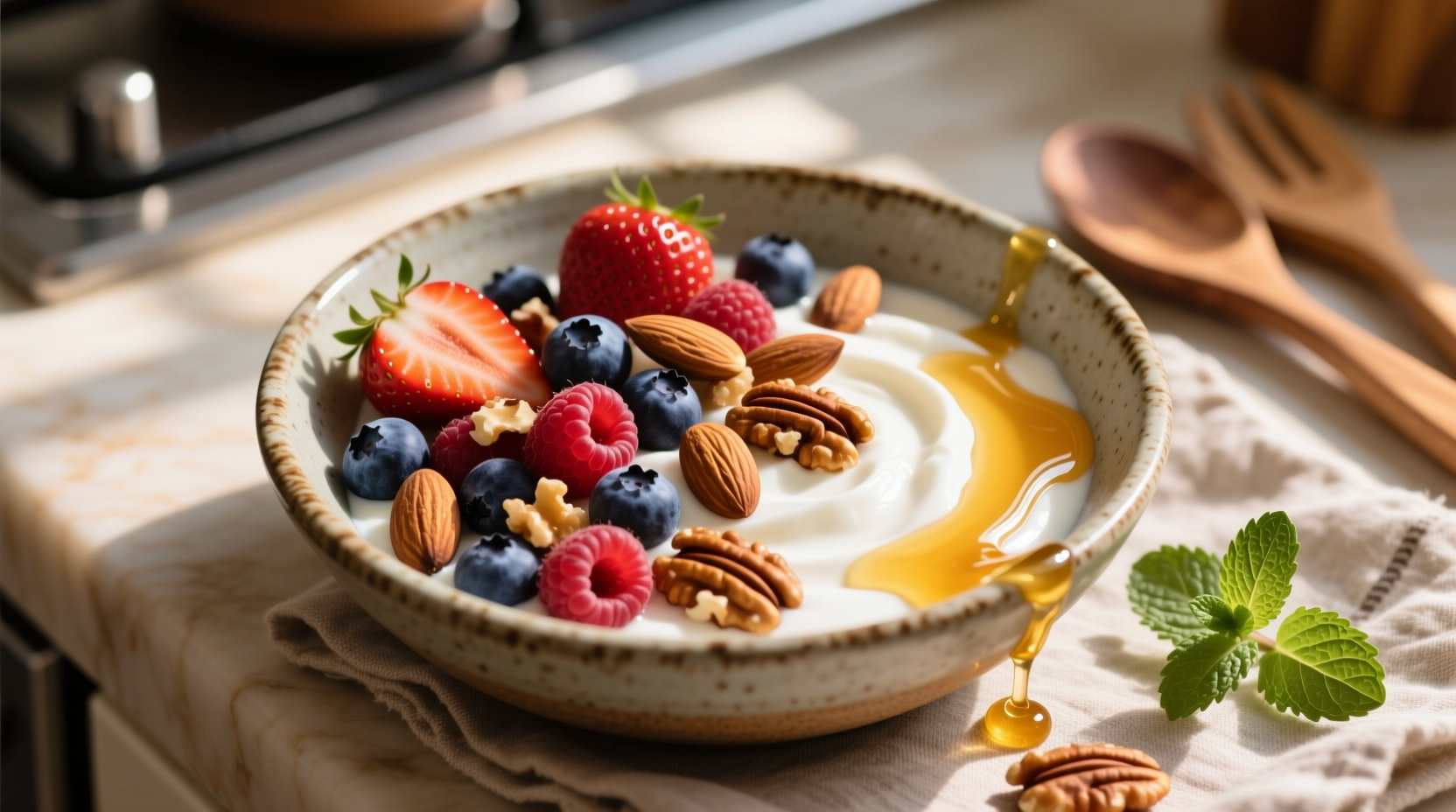Plain Greek yogurt packs double the protein of regular yogurt but often gets dismissed for its tart, thick texture. The secret to making it delicious isn't masking its qualities but enhancing them through smart flavor layering and texture adjustments—all while preserving its nutritional powerhouse status.
Why Greek Yogurt Tastes Different (And How to Work With It)
Greek yogurt undergoes additional straining that removes whey, resulting in higher protein concentration (17-20g per cup versus 9-12g in regular yogurt) and a naturally tangier profile. This concentrated form responds differently to flavor additions than regular yogurt—understanding this chemistry is key to successful customization.
| Natural Sweetener | Protein Impact | Glycemic Response | Best Pairings |
|---|---|---|---|
| Monk fruit extract | No impact | 0 | Berries, citrus |
| Raw honey | Maintains protein | Moderate | Nuts, cinnamon |
| Unsweetened applesauce | Preserves protein | Low | Oats, walnuts |
| Stevia | No impact | 0 | Tropical fruits |
This comparison of natural sweeteners, based on USDA nutritional data, shows how different options affect Greek yogurt's core benefits. Unlike regular yogurt, Greek yogurt's dense protein structure can handle liquid additions without becoming watery—when done correctly.
5-Minute Flavor Transformations (No Cooking Required)
Start with these immediate upgrades that require only ingredients you likely have on hand:
The Temperature Trick
Remove yogurt from the refrigerator 15-20 minutes before serving. Cold temperatures suppress flavor receptors—room temperature yogurt reveals subtle sweetness naturally. This simple technique works because taste perception decreases by approximately 30% at cold temperatures according to research from the Monell Chemical Senses Center.
Layering Method vs. Mixing
Instead of stirring additions directly into the yogurt:
- Place fruit at the bottom of your bowl
- Add Greek yogurt on top
- Sprinkle nuts or seeds over the yogurt
This creates flavor pockets with each bite while maintaining yogurt's texture integrity. Professional chefs use this technique because it prevents the yogurt from becoming watery—a common issue when mixing in juicy fruits.
Advanced Flavor Development Techniques
Dry-Toast Spices Before Adding
Toast spices like cinnamon, cardamom, or cumin in a dry pan for 60-90 seconds before sprinkling on yogurt. This process, recommended by culinary experts at the Culinary Institute of America, releases essential oils that dramatically enhance flavor complexity without adding calories.

The Citrus Zest Secret
Microplane citrus zest (lemon, orange, or lime) directly into yogurt for bright flavor without acidity. The oils in zest contain potent flavor compounds that complement Greek yogurt's tanginess. One teaspoon of zest equals the flavor impact of two tablespoons of juice—without the liquid that dilutes texture.
Texture Adjustments for Perfect Mouthfeel
Greek yogurt's thickness can feel chalky to some palates. Fix this without compromising protein content:
- Thinning technique: Stir in a teaspoon of full-fat coconut milk instead of water or regular milk—adds creaminess without separation
- Creaminess boost: Blend in one tablespoon of almond butter per cup of yogurt for velvety texture and healthy fats
- Crunch factor: Top with toasted coconut flakes or crushed pecans for textural contrast that satisfies like higher-sugar alternatives
Meal-Specific Applications
Breakfast Power Bowl Formula
Combine:
- 1 cup plain Greek yogurt
- 1/4 cup toasted buckwheat groats (kasha)
- 1/2 cup mixed berries
- 1 tsp chia seeds soaked in 2 tsp water
- Pinch of sea salt
This combination provides 25g protein, 10g fiber, and balanced macronutrients that keep you full for hours. The salt enhances all flavors while counteracting any residual tartness.
Savory Yogurt Transformation
For tzatziki or raita-style applications:
- Drain excess liquid from grated cucumber for 10 minutes
- Mix with yogurt, fresh dill, and a squeeze of lemon
- Add minced garlic that's been soaked in cold water for 5 minutes (reduces harshness)
This method, documented in traditional Mediterranean cooking practices, creates balanced savory yogurt without the watery texture common in amateur attempts.
What Not to Do: Common Mistakes
Avoid these pitfalls that ruin Greek yogurt's texture and nutritional profile:
- Sugar overload: Adding more than 1 tablespoon of sweetener per cup negates the low-sugar benefit
- Watery fruit mixing: Stirring in fresh pineapple or melon directly causes separation—marinate first in citrus juice
- Over-chilling: Freezing Greek yogurt changes its protein structure permanently, creating an unpleasant grainy texture when thawed
Global Yogurt Traditions for Inspiration
Explore how different cultures enhance plain yogurt:
- Greek tradition: Drizzle with thyme honey and walnuts (the honey's floral notes balance tartness)
- Indian raita: Cucumber, roasted cumin powder, and fresh mint (the cumin's earthiness complements yogurt's tang)
- Turkish süzme: Served with pomegranate molasses and pistachios (the molasses' tart-sweet profile mirrors yogurt's own characteristics)
These traditional preparations demonstrate how cultures worldwide have perfected yogurt enhancement without compromising its nutritional value—a practice documented in food anthropology research dating back centuries.











 浙公网安备
33010002000092号
浙公网安备
33010002000092号 浙B2-20120091-4
浙B2-20120091-4